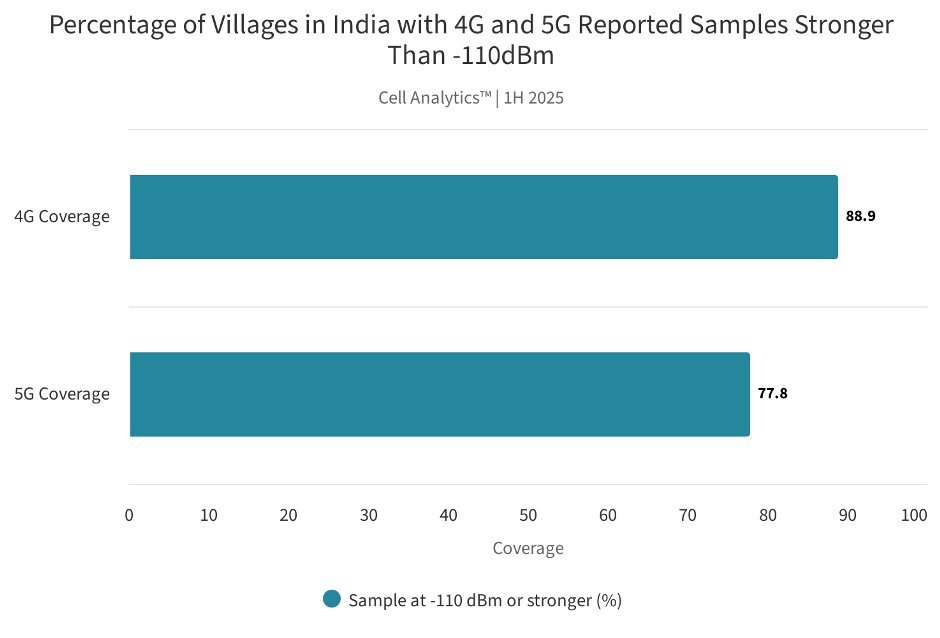India’s telecommunications sector continues to evolve rapidly, driven by affordable tariffs, wider service availability, and the rollout of new technologies such as 4G and 5G. The nation’s wireless subscriber base reached 117.1 crore (1.17 billion) by June 2025, reflecting growth across three years, according to data from the Telecom Regulatory Authority of India (TRAI).

However, phone customers in Rural India continue to face a significant digital divide. While India’s mobile subscriber base expands, a clear urban-rural gap persists. Urban areas boast a robust mobile penetration rate of 125.3 percent, indicating multi-device usage, whereas rural regions lag at just 58.8 percent. This 66.5-percentage-point disparity highlights the urgent need for targeted development to improve access and overcome infrastructural barriers to mobile connectivity, Affandy Johan, analyst at Ookla, said in a report released on October 8.
4G and 5G Connectivity in Rural India
In the first half of 2025, 4G networks demonstrated widespread penetration in rural India. Data samples showed signal strengths stronger than -110 dBm in 88.9 percent of villages, underscoring the success of 4G as a foundational broadband technology.
The deployment of 5G is also progressing swiftly. Coverage was detected in 77.8 percent of villages, reflecting an 11.1-percentage-point difference between 4G and 5G coverage — a result of a phased rollout strategy prioritizing densely populated areas before expanding to rural and remote regions.
These numbers highlight the strong performance of India’s telecom networks and the continued progress toward nationwide high-speed mobile coverage.
Performance Improvements Across States and Union Territories
Most Indian states and union territories have reported median mobile download speeds exceeding 40 Mbps, largely attributed to the introduction and expansion of 5G networks. This has led to substantial nationwide improvements in connectivity and data performance.
Urbanized areas and smaller territories remain at the forefront of this progress:
Delhi: 168.14 Mbps (highest in India)
Chandigarh: 115.71 Mbps
Puducherry: 114.35 Mbps
Meanwhile, data from the lower 10th percentile download speed shows significant performance gains in areas that previously suffered from slower networks. Lakshadweep’s bottom 10th percentile speed increased more than thirteen-fold, from 0.68 Mbps in 1H 2024 to 8.99 Mbps in 1H 2025.
This remarkable improvement is a direct outcome of government initiatives such as the BharatNet project, which aims to expand broadband and mobile connectivity infrastructure across every part of India — including islands and geographically challenging regions.
Government Programs Empowering Digital Inclusion
To bridge the rural-urban connectivity gap, the Government of India has launched several strategic initiatives:
Digital Bharat Nidhi (formerly USOF): Funds telecom infrastructure in commercially unviable rural regions.
BharatNet Project: Connects over 250,000 Gram Panchayats via optical fiber; as of early 2025, around 220,000 were already service-ready.
4G Saturation Project: Ensures mobile access to every uncovered village.
Amended BharatNet Program: Enhances last-mile connectivity using both fiber and satellite technologies.
These programs collectively serve as the backbone of India’s rural telecom revolution, enabling faster and more reliable digital access for millions.
The Road Ahead: Collaboration for Universal Digital Access
India’s digital transformation is well underway, but last-mile connectivity remains a persistent challenge. Strengthening public-private partnerships, offering policy incentives, and accelerating infrastructure projects are vital steps toward achieving universal mobile coverage.
Indian telecom operators are complementing government efforts with rapid 5G rollouts and affordable devices, such as JioBharat phones, to promote adoption in lower-income segments. Continued collaboration among regulators, telecom companies, and technology providers is key to ensuring equitable access and digital empowerment across rural India.
Toward Inclusive Digital Empowerment
Mobile connectivity has become a powerful enabler of social and economic transformation in India. Improved mobile and internet access opens up new opportunities in education, healthcare, agriculture, and digital entrepreneurship.
With the combined push from 5G expansion, rural infrastructure development, and government-led digital initiatives, India is steadily closing its digital gap. The goal is clear — to ensure that every Indian village, regardless of geography or population density, enjoys reliable, high-speed mobile connectivity, realizing the full potential of Digital India.
Baburajan Kizhakedath
